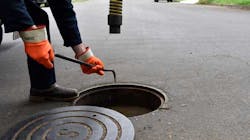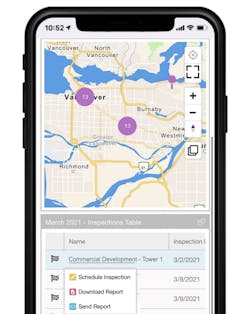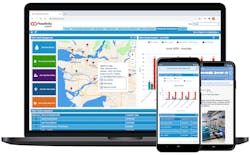Many water professionals know that when it comes to data collection, their reliance on disconnected paper forms, spreadsheets, and legacy systems is holding them back. The digital age brings many opportunities to streamline operations. However, utilities also must find ways to balance the challenges of increased demand, new regulations, and aging infrastructure with tight budgets.
For many, the answer has been to attempt digitization with a piecemeal approach. Sometimes, this comes as a simple mobile form solution or through scaling up investments in GIS. Although this is a step in the right direction, the ROI often proves disappointing when the benefits are weighed against time, effort, and expense.
Many existing software solutions can only solve parts of the utility operations puzzle. Simple mobile forms are no help if staff still spend time uploading photographs and emailing attachments. And what use is data visualization if it cannot augment operations and reporting?
However, utility managers are now empowered to create flexible custom applications quickly and without code. This ability comes with the onset of “no-code platforms,” based on business logic, relational databases, and point-and-click application building tools.
With these platforms, almost any workflow, from field inspections to lab sampling, can be digitized, automated, and integrated — replacing outdated processes and ensuring a meaningful ROI.
Digitize and Centralize Data
Ensuring the accuracy of operational data is key to successful water utility management. Whether inspecting a construction project, capturing lab samples, or monitoring assets and facilities, data collection plays a crucial role in a utility’s operations.
But despite its importance, many utilities are still capturing and storing data in a mixture of paper forms, spreadsheets, and disconnected legacy software systems. Digitizing data collection can remove the frustrations, delays, and risks of paper-based processes by capturing and storing data in a more accessible, reliable way.
No-code toolsets allow users to replicate paper forms in a digital format using point-and-click tools. Paper forms that have been around for years can be digitized and improved in an afternoon.
With paper forms, field and facility teams often must make annotations and take photographs separately. Organizing these additional steps ensures inspections are complete upon submission. But, with no-code apps, users can take and annotate photos, record audio memos, and capture high-precision coordinates from within a data collection app. These can often be embedded within the same form, meaning no more paper, pens, or additional time spent uploading images from devices.
The applications can also perform on-device calculations and workflow logic, guiding users through submission processes with ease and precision. Validating data and streamlining this process in the field helps ensure records are accurate and error-free.
Once recorded, this data can often be submitted to a centralized database, making it instantly available to everyone, whether in the field or office. These applications are also inherently flexible, meaning that if regulatory or workflow requirements change, utility managers can quickly update their apps.
The apps are also centrally controlled, with utility managers able to push updates out to all devices with the click of a button. This helps ensure that every employee has the latest app versions and has the information required to do their jobs effectively.
Create and Automate Custom Workflows
With digital data collection in place, the applications can also create and automate operational workflows. This may sound expensive or beyond the capacity of smaller utilities, but no-code applications are able to streamline processes using the same visual toolset that digitizes data collection.
To create a custom water utility management application without code, a utility only needs to know who needs to use the data, what circumstances change this data, and when that data needs to be actioned.
Using a no-code platform, many utilities can quickly use these business rules to create custom utility management apps.
Utilities can then automate workflows by feeding data to the correct individuals using business logic and a visual app editor. This is made possible by leveraging a centralized database and process automations.
Streamline Work Order Dispatch
Most utilities perform regular fieldwork, sending technicians to conduct inspections or maintenance before returning with completed forms.
These workflows often include approval hierarchies, so when inspection data is collected, it needs to be reviewed and approved by different people throughout an organization, whether in the field, facility or back at the office.
With no-code apps, successful utility managers can improve efficiency by assigning, monitoring, and approving field and facility data in real-time. This speeds up manual processes, as the needed data isn’t trapped in paper forms or spreadsheets.
Field or facility workers would be able to complete and submit their work, reference existing data, and schedule additional tasks from anywhere. This reduces the likelihood of field errors or omissions that can lead to repeat visits or inspections.
All of this can be achieved without a single line of code, using intuitive point-and-click toolsets to design how data moves through the desired workflow.
All Data on One System
Whatever the benefits of a custom water utility management system, utilities also need to maintain various specialist systems, such as SCADA or GIS systems. But this doesn’t mean utility managers need to persist with data siloed across separate specialist systems.
Often, these disparate technologies can be integrated with a centralized database, bringing together all operational data into one unified, custom system. This provides utilities with significant benefits, saving time, and reducing the risk of data loss or duplication, while managers can now get unprecedented insight into their operations with a single, central system.
Real-time Dashboards
Using a no-code platform, utility managers can improve insight into operations and help make better decisions by visualizing their data. The apps are often able to feature customizable, interactive dashboards, which can display key performance indicators in real-time.
Utility managers could also use these dashboards to visualize and monitor their existing SCADA systems and to manage their field and facility operations from GIS maps.
The dashboards can also be tied to workflows and act as a central hub, allowing utility managers to create, assign, and approve records without leaving the dashboard.
Track and Manage Assets
The platforms can leverage IoT computing to enhance real-time asset management, augmenting and expanding the reach of existing SCADA systems. Controller devices and sensors can automate data collection and provide real-time insight into asset performance.
Tying these physical assets to a digital workflow provides a unique opportunity to create and automate end-to-end workflows — while also providing unprecedented real-time insight into an entire organization.
Monitoring and tracking lab samples, commonly not covered by supervisory systems, offers new opportunities to create a unified data management system, feeding actionable intelligence to data-driven processes.
Conclusion
Choosing the right no-code platform empowers utilities to easily combine flexible data collection, custom workflow capabilities, centralized databases, and IoT solutions with specialist software. A custom, cost-effective water utility management system will help utilities reduce their reliance on paper forms, spreadsheets, and legacy systems. WW
Published in WaterWorld magazine, January 2022.
About the Author

Sean King
Sean King is a marketing communications specialist for Flowfinity Wireless Inc.. Email him at [email protected].


